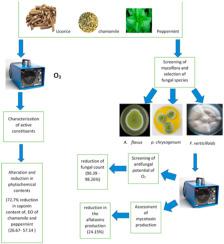Environmental Pollution ( IF 8.9 ) Pub Date : 2021-02-11 , DOI: 10.1016/j.envpol.2021.116715 Salama A. Ouf , Enas M. Ali

|
Herbs and spices are food crops susceptible to contamination by toxigenic fungi. Ozone, as a decontamination approach in the industry, has attractive benefits over traditional food preservation practices. A contribution to the studying of ozone as an antifungal and anti-mycotoxigenic agent in herbs and spices storage processes is achieved in this research. Nine powdered sun-dried herbs and spices were analyzed for their fungal contamination. The results indicate that licorice root and peppermint leaves were found to have the highest population of fungi while black cumin and fennel record the lowest population. The most dominant fungal genera are Aspergillus, Penicillium, Fusarium, and Rhizopus. Ozone treatment was performed at a concentration of 3 ppm applied for exposure times of 0, 30, 90, 150, 210, and 280 min. After 280 min of exposure to ozone, the reduction of fungal count ranged from 96.39 to 98.26%. The maximum reduction in spore production was achieved in the case of A. humicola and Trichderma viride exposed for 210 min ozone gas. There was a remarkable reduction in the production of the total mycotoxin, reaching 24.15% in aflatoxins for the 150 min-treated inoculum in the case of A. flavus. The total volume of essential oil of chamomile and peppermint was reduced by 57.14 and 26.67%, respectively, when exposed to 3 ppm.
For 280 min. In conclusion, fumigation with ozone gas can be used as a suitable method for achieving sanitation and decreasing microbial load in herbs and spices. Still, it is crucial to provide precautions on ozone’s effect on major active constituents before recommending this method for industrial application.
中文翻译:

用臭氧作为真菌去污剂处理干草药是否会影响活性成分?
草药和香料是易受产毒真菌污染的粮食作物。臭氧作为工业中的一种去污方法,比传统的食品保存方法具有明显的优势。这项研究为臭氧在草药和香料存储过程中作为抗真菌和抗霉菌毒素制剂的研究做出了贡献。分析了九种粉末状的晒干草药和香料的真菌污染。结果表明,甘草根和薄荷叶被发现具有最高的真菌种群,而黑孜然和茴香则被发现具有最低的真菌种群。最主要的真菌属是曲霉菌,青霉菌,镰刀菌属和根霉菌属。臭氧处理的浓度为3 ppm,暴露时间分别为0、30、90、150、210和280分钟。暴露于臭氧280分钟后,真菌数量减少范围为96.39至98.26%。在暴露于210分钟臭氧气体的h。aumi humicola和Trichderma viride的情况下,孢子产生最大程度地减少。总黄曲霉毒素的产量显着减少,黄曲霉毒素经150分钟处理后的接种物中黄曲霉毒素的产量降低了24.15%。当暴露于3 ppm时,洋甘菊和薄荷的精油总量分别减少了57.14和26.67%。
280分钟 总之,用臭氧气体熏蒸可以用作实现卫生和减少草药和香料中微生物负荷的合适方法。但是,在推荐将该方法用于工业应用之前,必须提供预防措施,以防止臭氧对主要活性成分的影响,这一点至关重要。


























 京公网安备 11010802027423号
京公网安备 11010802027423号